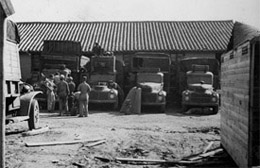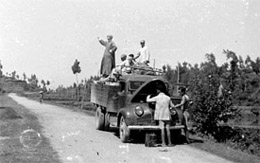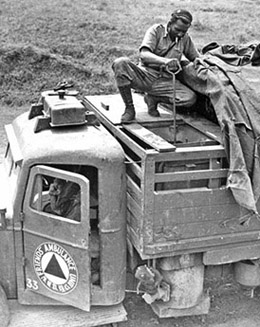The Convoy had been invited into China to undertake the distribution of medical supplies primarily to the Chinese Army but also to civilian hospitals. Their immediate task on arrival was to truck those supplies into China through the Burma Road which ran from Lashio in north eastern Burma and then on to Kunming.
The Nationalist Chinese Government determined that no trucks should travel empty and return cargoes of non-relief supplies included metals, fuel, building materials, salt, machinery, food and, when possible, refugees and the sick and wounded.
With the fall of Burma petrol and diesel supplies were cut and so alternatives were sought, including vegetable oil and alcohol each of which were extremely expensive. The most readily attainable and affordable option was to convert the trucks to run on charcoal gas. The Convoy’s Michael Fox, Peter Rowlands and others refined the application of this technology, in which a system of pipe-work circumnavigated the vehicles, cooling and filtering the emissions from a charcoal fire before delivering the “producer gas” into the engine.
The trucks were slow but they worked, except when they sometimes stalled on hills. Then the driver’s assistant chocked the wheels to hold the vehicle in place while the driver coaxed the engine into delivering more power. This process often had to be repeated several times on the same ascent and one account recalls climbing less than a mile in two and a half hours.
Eventually convoys started running the 6,000 km and 6 weeks round trip to the low grade oilfields of Gansu in the far North West, beyond the Great Wall on the edge of the Gobi desert. This provided some alternative fuel, until early 1945 when overland supplies of better fuel resumed.
Although the roads were spectacular and the scenery extraordinary, the gradients were punishing and the ravines precipitous. The road surfaces themselves were unforgiving of inattentiveness and in the dry season chokingly dusty, but in the wet season they turned to mud and were often blocked by landslides. The route between Chungking and Lushien climbed to 10,000ft but the most dramatic stretch was the 24 bends of Annan between Kutsing and Guiyang.
The narrowness of most roads presented challenges to concepts of both right of way and of face. There was no highway code; except the convention that the person with the biggest vehicle drove in the middle or furthest from the precipice. Some trucks ended up in the ditch or worse, and had to be unloaded, dismantled, hauled back and reassembled Such incidents and frequent breakdowns and roadside repairs usually attracted quite a crowd of local onlookers, not least because the Chinese had rarely seen the foreign “big noses” doing any physical work or getting dirty.
Trucks ran over 200 days a year doing about 100km per day at about 15km / hour and carrying around 1 ½ tonnes of cargo. There was no average day and a truck could be on the road for 16 hours or longer. It is estimated that the FAU were responsible for the transportation of over 80% of medical supplies in unoccupied China.

 FAU China Convoy Reunion Group
FAU China Convoy Reunion Group  China Convoy Garage Depot
China Convoy Garage Depot
 Another breakdown
Another breakdown
 Stoking the Charcoal Hopper
Stoking the Charcoal Hopper